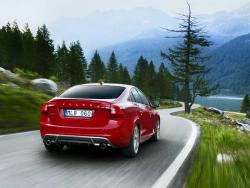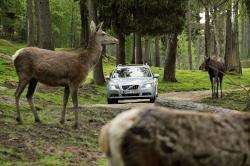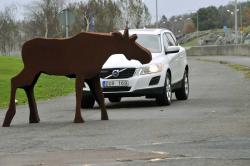Article by Justin Pritchard, photos courtesy Volvo
Moose are large, clumsy and delicious creatures characterized by their tree-like antlers, strong odour and awkwardly oversized genitals. Common in most Northern parts of the world, they are sometimes referred to as “swamp donkeys” or “Bullwinkles,” and spend approximately 87 percent of their lives eating tasty leaves (tasty to them, that is). The other 13 percent of a moose’s life is spent hunting for new leaves, drinking from ponds, and pooping.
  Northern Exposure: Car vs. Moose. Click image to enlarge |
Every year, moose everywhere wander into roadways — possibly attracted to the heat radiated by the pavement, or lured by the promise of new leaves on the other side of the road. Since a full-grown moose is about the size of a Volkswagen Touareg, they represent a safety hazard-and-a-half if they wind up in front of a moving vehicle.
In fact, according to information from Swedish automaker Volvo, drivers travelling through the Scandinavian wilderness at 110 km/h will pass within 300 meters of a large, “cloven-hoofed” animal, like a moose, about every 19 seconds. If you’re driving in the Canadian wilderness, the numbers could be similar.
The point? That’s a whole whackload of moose.
Hit one, and the most likely result will be a destroyed vehicle, as well as arm, hand and neck fractures, and glass lacerations to the face and arms. Head and neck fractures are also likely as the roof structure of the vehicle deforms into the passenger compartment when struck by the animal’s body. Bullwinkle’s centre of gravity — that is, the heavy business — is about 1.35 meters off the ground. So, you’ll probably take him out at the legs, and be left with many, many hundreds of kilograms of meat landing on your windshield and roof.
Thanks to a large animal accident research initiative, Volvo has made some interesting discoveries. In a simulation model, researchers created a situation where drivers could fully stop before hitting an animal when travelling at 90 km/h. With everything else held constant, an increase in vehicle speed to 100 km/h in this scenario saw drivers hitting the moose at 50 km/h.
 Northern Exposure: Car vs. Moose. Click image to enlarge |
Translation? Impact velocity versus velocity before brake application ahead of the animal impact is exponentially bad news.
Research also indicates that there’s a very narrow “grey zone”’ between mild injuries and serious ones in accidents like this. Speed, again, is important. The crucial speed zone according to Volvo, and considering things like headlight performance and average driver reaction times, is 80 to 90 km/h. In serious accidents and fatalities involving a collision with a large wilderness beast, a common sequence of events includes the car driving off the road or colliding with oncoming traffic following the initial impact.
In Sweden, they have moose as well — except that they’re called elk. Whatever the large, clumsy cloven-hoofed animal, maximum protection from a vehicular impact comes from early detection that could see the collision avoided altogether.











